Chapter Three
Dangerous Concept, Dangerous Times: Galileo, Kepler and the Church
Page 6The loss of body parts has always fascinated me. I run across many such cases in my study of early modern medicine. Tycho Brahe, better known for his astronomical interests, is one of the more famous victims. As a youth of the Danish nobility, he was permitted to carry a sword and had a habit of using it in tavern brawls. In one such incident he failed to parry and paid with his nose, clipped right up to the septum. — J. R. Salling The Collected Noses of Tycho Brahe
University & Mundane Astrologer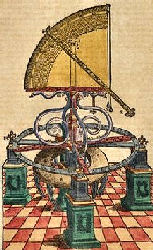 The beginning of the 17th century saw the zenith for observational astronomy, marking the end of "naked-eye" research. Yet, as the 16th century came to a close, it still had one additional and lasting acheivement to leave science. As noted by editor Christina J. Moose in her article Tycho Brahe:
The beginning of the 17th century saw the zenith for observational astronomy, marking the end of "naked-eye" research. Yet, as the 16th century came to a close, it still had one additional and lasting acheivement to leave science. As noted by editor Christina J. Moose in her article Tycho Brahe:"Brahe's observatories on the island of Hveen represented the state of the art in sixteenth century astronomical observations. Here he gazed at the stars, recorded his observations, made his mathematical computations, and had his most famous instruments built and installed: three equatorial armillae; a mural quadrant, which he used to determine time; and sextants with transversals on the graduated arc and improved sights that allowed for pointing the instrument with great precision to measure distances and angles." Seen at left is an image of Tycho's medium sized Azimuth Quadrant of brass, courtesy BibliOdyssey: Tycho Mechanica. [1] As previously mentioned, Tycho left Leipzig University in 1565 and returned to his home in Copenhagen. However, he didn't remain there long, finding himself ready to leave after receiving a less then cordial reception from his family on account of his decision to become a student of science rather than law. In fact, the only family encouragment in his endeavour to pursue astronomy seems to have come from his uncle, Steen Bille, who believed it a much wiser choice to allow Tycho to follow his own inclinations in the matter, later providing Tycho with help in constructing an observatory and alchemy laboratory at Herrevad Abbey. After the death of his uncle, Jørgen brahe, there was little to keep Tycho at home and so in 1566, he travelled to Germany, arriving at both the city and University of Wittenberg in April of that year. [2]
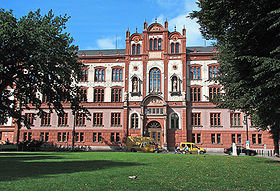
Though a leading institution at the time, little is known of Tycho's movements while at the University of Wittenberg other than that his stay there was very short. Due to an outbreak of the plauge, he was naturally inclined to leave the city, doing so in September of that same year, having spent only five months at the university. He arrived in the city of Rostock during the second week of September and was admitted to the university on the 24th of that month. Yet, Tycho's choice was surely a matter of where to go in a hurry then a carefully thought out decision, as the university did not have an academic program in astronomy. Whatever the case may have been, the end of 1566 saw the occurrence of two events that give us some insight into the lesser known aspects of his talents and character. Shown at right is the University of Rostock's central building and entrance courtesy Wikipedia.
-fn1 Shortly after his enrollment, Tycho witnessed a lunar eclispe on October 28th and predicted that it foretold the death of the Turkish Sultan Soliman (Suleyman the Magnificient or Suleyman I), an event which came to pass. "What is often forgotten, or simply ignored by historians of science, was that Brahe was also a mundane astrologer. Mundane astrology studies the charts of nations that are read much as are charts of individuals." [3] There was but one drawback to Tycho's prediction however, as the Sultan Soliman had died prior to the occurrence of the lunar eclispe, having fallen during the seige of the Hungarian fortress of Szigetvár ( Szigeth ) on September 6th. Despite some sneering over the timing of his prediction, Tycho was able to explain it away. Then, in December of that same year, he became involved in an incident which left him with some very uncomfortable results—for the rest of his life. [4] Tycho Brahe's Nose, 1566
It happened in 1566 while the 20-year-old Tycho was studying at the University of Rostock in Germany. Attending a dance at a professor's house, he got into a quarrel with one Manderup Parsbjerg, like himself a member of the Danish gentry. Over a woman? Nah--tradition has it that the two were fighting over some fine point of mathematics. (My guess: Fermat's Next-to-Last Theorem, which posits that 2 + 2 = 5 for very large values of 2.) Friends separated them, but they got into it again at a Christmas party a couple weeks later and decided to take it outside in the form of a duel. Unfortunately for Tycho the duel was conducted in pitch darkness with swords. Parsbjerg, a little quicker off the dime, succeeded in slicing off the bridge (apparently) of Tycho's nose — Cecil Adams, in answer to Raymond Johnston, chief copy editor of the Prague Post, 2009 [5]
One may not think a man of science to have much of a temper, but Tycho became famous for his. It was a character trait that has given history its second most famous aspect on the life of Tycho Brahe.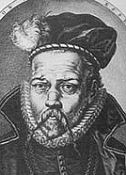 If anything can be said regarding the incident in which Tycho lost part of his nose, it is that the duel in which it happened has become almost as well known as is his extremely accurate records of naked-eye star observations and perhaps as popular and notable as his pet Moose, which drank beer and a court jester and dwarf named Jepp that Tycho believed was a clairvoyant. The story is interesting in that the incident lasted only a minute or so at most, while the results of the duel left Tycho with a life long disfigurement that required the use of a metal alloy prosthesis that could not, considering the location of the wound, be hidden. At left is a portrait of Tycho Brahe, clearly showing his damaged nose. Additional portraits of Tycho can be found at the MacTutor History of Mathematics website at the University of St. Andrews in Scotland.
If anything can be said regarding the incident in which Tycho lost part of his nose, it is that the duel in which it happened has become almost as well known as is his extremely accurate records of naked-eye star observations and perhaps as popular and notable as his pet Moose, which drank beer and a court jester and dwarf named Jepp that Tycho believed was a clairvoyant. The story is interesting in that the incident lasted only a minute or so at most, while the results of the duel left Tycho with a life long disfigurement that required the use of a metal alloy prosthesis that could not, considering the location of the wound, be hidden. At left is a portrait of Tycho Brahe, clearly showing his damaged nose. Additional portraits of Tycho can be found at the MacTutor History of Mathematics website at the University of St. Andrews in Scotland.An account of the duel can be found in the latin written Tycho Brahe, the man and his work, by Pierre Gassendi (1654), which was translated to swedish and commented by Wilhelm Norlind, 1951. Writes Gassendi:
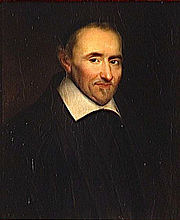 The 10th of december 1566 there was a dance at Lucas Bacmeisters house in the connection to a wedding. Lucas Bacmeister was a professor of theology at the univeristy of Rostock where Tycho studied. Among the guests were Tycho Brahe and another danish nobleman, Manderup Parsberg. They started an argument and they separated in anger. The 27th of december this argument started again, and in the evening of the 29th of december a duel was held. It was around 7 in the evening and in darkness. Parsberg gives Tycho a cut over his nose that took away almost the front part of his nose. Tycho had an artificial nose made, not from wax, but from an alloy of gold and silver and put it on so skillfully, that it looked like a real nose Wilhelm Janszoon Blaeu, who spent time with Tycho for nearly two years, also said that Tycho used to carry a small box with a paste or glue, with which he often would put on the nose. Shown at right is a portrait of Pierre Gassendi, painted by Louis Édouard Rioult. [6]
The 10th of december 1566 there was a dance at Lucas Bacmeisters house in the connection to a wedding. Lucas Bacmeister was a professor of theology at the univeristy of Rostock where Tycho studied. Among the guests were Tycho Brahe and another danish nobleman, Manderup Parsberg. They started an argument and they separated in anger. The 27th of december this argument started again, and in the evening of the 29th of december a duel was held. It was around 7 in the evening and in darkness. Parsberg gives Tycho a cut over his nose that took away almost the front part of his nose. Tycho had an artificial nose made, not from wax, but from an alloy of gold and silver and put it on so skillfully, that it looked like a real nose Wilhelm Janszoon Blaeu, who spent time with Tycho for nearly two years, also said that Tycho used to carry a small box with a paste or glue, with which he often would put on the nose. Shown at right is a portrait of Pierre Gassendi, painted by Louis Édouard Rioult. [6]
-fn2
Eclipse, Notable Persons and Göggingen
Simplicibus itaque verbis gaudet Mathematica Veritas, cum etiam per se simplex sit Veritatis oratio. — Tycho Brahe, Epistolarum astronomicarum liber primus (1596) [7]
Tycho Brahe, 1566 to 1572Between the end of 1566 and the beginning of 1572 Tycho moved about the European countryside quite a bit and while we do know that he recorded his observations, a good deal of his history at this time is more the result of where he eventually showed up. What follows is a precis from J. L. E Dreyer's techinical biography on Tycho.
 In April of 1567 Tycho observed an eclipse of the sun which was "seven digits" at Rostock. Thereafter, in the summer of that year, Tycho returned home but doesn't seem to have received a very warm welcome and therefore was back at Rostock at the end of that year.
In April of 1567 Tycho observed an eclipse of the sun which was "seven digits" at Rostock. Thereafter, in the summer of that year, Tycho returned home but doesn't seem to have received a very warm welcome and therefore was back at Rostock at the end of that year.-fn3 In 1568, having returned to Rostock, Tycho began almost immediately to make recorded observations. Since he was still bereft of any instruments at this time, Tycho had to be content with simply jotting down the positions of Jupiter and Saturn in relation to the stars. On May 14 he was given, under the hand of King Frederick II, a formal promise of the first vacant canonry. Towards the last portion of the year, Tycho returned to Wittenberg and was in Basle where he was enrolled at the University, remaining there until the early part of 1569.
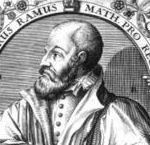
It was during this period that Tycho also made the acquaintance of a few of the more notable and forward thinkers of his day. This included men like the educational reformer Pierre de la Ramée, astronomer Cyprianuis Leovitius, German historian and humanist Hieronymus Wolf, Philip Apianus, son of the famous Pete Apianus and author of Astronomicum Cæsareum and the German astronomer and the mayor of Augsburg Paul Hainzel and his brother Johannes Baptista Hainzel. Shown at right is an image of Pierre de la Ramée (Petrus Ramus) courtsey Wikipedia. Tycho eventually settled at Augsburg, the city most dear to Protestants at that time due to its position as center stage for that era's reform movement under the 1555 Peace of Augsburg settlement. It was here that Tycho constructed his first of many observing instrument; it was his opinion that those at hand were just too simple for accurate scientific purposes. In collaboration with Paul Hainzel, they built a large azimuthal quadrant (used to measure the heigth of stars) of about 19 feet, erecting the device on the top of a hill on Hainzel's estate in Göggingen, where, in 1572, it was used to measure the new star (supernova SN 1572) and a handful of fixed stars. The quadrant remained at Hainzel's estate until it was destroyed by a storm in December of 1574.
1572—1574
I was so astonished at this sight that I was not ashamed to doubt the trustworthiness of my own eyes. But when I observed that others, too, on having the place pointed out to them, could see that there was a star there, I had no further doubts. A miracle indeed, either the greatest of all that have occurred in the whole range of nature since the beginning of the world, or one certainly that is to be classed with those attested by the Holy Oracles. — Tycho Brahe, De Stella Nova, 1573. Quoted in H. Shapley and A. E. Howarth (eds.), Source Book in Astronomy (1929), p.13
Tycho Brahe, 1572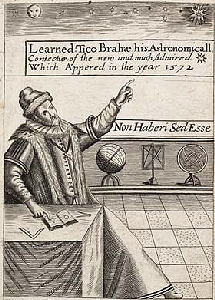 On November 11, 1572 Tycho was returning to his home when, looking up towards the constellation of Cassiopeia, he noticed a star where none had been before. Since he had just completed construction of a new sextant instrument, which had a much higher degree of accuracy than earlier cross-staff devices, he was able to measure the distance of the new object with the device using the known stars within Cassiopea. For Tycho, the appearence of the new star was most portentous and for the rest of his life no other single event would be more influential in shaping his path and career.
In addition to the use of the new instrument he had built at Göggingen, Tycho also came to the conclusion—making it his life's work from this point forward— that the study of astronomy was in sore need of exactly what he had said it needed earlier in 1563, "a long term project with the aim of mapping the heavens conducted from a single location over a period of several years." There was also the publication of his small but famous book, De nova stella in 1573, that would gain Tycho the notice of those who were in the most favorable position to grant him the resources he needed most, in order to begin his observations of the heavens. Although he had no idea as to how much his book would actually accomplish in this respect, the appearence of the new star (supernova SN 1572) in Cassiopeia was, in many ways, a watershed in Tycho's career: his growing fame had changed the attitudes of his family and peers toward his astronomical work; his maternal uncle Steen Bille's support of his desires led to the use of a lab outfitted for him and was the location from where he observed the new star; his renown began to grow from this point forward and he was soon offered scientific positions all over Europe, resulting in a most famous and generous offer of help. Finally, the appearence of the new star brought something to light that was to have far more influential consequences on the study and history of astronomy—it proved the fact that the universe was indeed mutable (a concept that Galileo would also come to embrace). Shown above left is an image from the English reprinting (1632) of Tycho Brahe's De nova stella, originally published in Copenhagen in 1573. It is one of two additional images added to this version of his book and shows Tycho pointing to the new star in the constellation of Cassiopeia. [8]
On November 11, 1572 Tycho was returning to his home when, looking up towards the constellation of Cassiopeia, he noticed a star where none had been before. Since he had just completed construction of a new sextant instrument, which had a much higher degree of accuracy than earlier cross-staff devices, he was able to measure the distance of the new object with the device using the known stars within Cassiopea. For Tycho, the appearence of the new star was most portentous and for the rest of his life no other single event would be more influential in shaping his path and career.
In addition to the use of the new instrument he had built at Göggingen, Tycho also came to the conclusion—making it his life's work from this point forward— that the study of astronomy was in sore need of exactly what he had said it needed earlier in 1563, "a long term project with the aim of mapping the heavens conducted from a single location over a period of several years." There was also the publication of his small but famous book, De nova stella in 1573, that would gain Tycho the notice of those who were in the most favorable position to grant him the resources he needed most, in order to begin his observations of the heavens. Although he had no idea as to how much his book would actually accomplish in this respect, the appearence of the new star (supernova SN 1572) in Cassiopeia was, in many ways, a watershed in Tycho's career: his growing fame had changed the attitudes of his family and peers toward his astronomical work; his maternal uncle Steen Bille's support of his desires led to the use of a lab outfitted for him and was the location from where he observed the new star; his renown began to grow from this point forward and he was soon offered scientific positions all over Europe, resulting in a most famous and generous offer of help. Finally, the appearence of the new star brought something to light that was to have far more influential consequences on the study and history of astronomy—it proved the fact that the universe was indeed mutable (a concept that Galileo would also come to embrace). Shown above left is an image from the English reprinting (1632) of Tycho Brahe's De nova stella, originally published in Copenhagen in 1573. It is one of two additional images added to this version of his book and shows Tycho pointing to the new star in the constellation of Cassiopeia. [8]-fn4 De nova stella
O crassa ingenia. O caecos coeli spectatores — Tycho Brahe, his preface to De Stella Nova, 1573
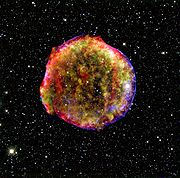 In 1572, Tycho showed some reluctant in publishing his observations on the new star, due in no small measure to the fact that it was perceived as beneath a noble to write books; himself indicating this prejudice amongst his peers as a reason for not going to publication. Another reason may have been his developing desire for secrecy, a trait that Tycho was now beginning to exhibit. Keeping his data "secret" was one of the reason behind the later frustration and friction between Kepler and himself. In any case, it wasn't until his second return to Copenhagen that he was persuaded to publish his work, at the urging of several friends including Peder Oxe, who was the High Treasurer of Denmark and related to Tycho; Oxes' sister was the wife of Jørgen Brahe and was therefore a second mother to Tycho. Seen at right is Tycho's supernova remnant, the left over of the original star, a gas cloud that is extremely hot. Image courtesy the APOD website. Image credit X-ray: NASA/CXC/SAO; Infrared: NASA/JPL-Caltech; Optical: MPIA, Calar Alto, O. Krause et al. [9]
A more compelling reason that pushed Tycho pass his reluctance to publish—and in keeping with his steadfast desire for more accurate stellar observations—was the fact that the new star had also been observed by astronomers and astrologers alike, with many of the existing "scientific" community around Europe having commented or written upon the star's appearence; reportedly, several so badly in error of the stars position that Tycho must have wondered if they ever saw it at all. As these commentaries on the new star came to his attention, Tycho realized how far off the mark most were. The result of this conclusion was a strongly worded criticism of his contemporaries at the time, found in his preface to De Nova Stella, "O crassa ingenia. O caecos coeli spectatores" which translates from Latin as "Oh thick wits. Oh blind watchers of the sky". [10]
De Stella Nova was initially printed in small quanities and saw little distribution (though it was well received by those to whom it mattered, gaining Tycho a measure of fame and patronage) until it was reprinted in at least two further works, a 1632 English printed translation titled Learned Tico Brahae his Astronomicall coniectur in which were added two additional images (one of which is shown above) and a facsimile, Operum primitias De nova stella (Copenhagen), which was printed in 1901 as a tercentenary tribute to the authors memory; the book De Stellar Nova is also responsible for having coined the term "nova".
In the end, there ensued several very profound and lasting results from the publication of De Stella Nova, aside from the notice it brought Tycho. First was the determination he now held to begin setting the world of astronomy to rights and, perhaps most important of all, the publication's own inherent blow to the world as it was viewed by the church and others at that time. "Tycho discovered that the new star did not shift its position with respect to the other stars, and therefore it really was a star. Since conventional opinion held that the heavens were perfect and unchanging, this was quit a shock, but Tycho's evidence was so convincing that his treatise marked the beginning of the end of the doctrine of the immutability of the heavens." [11]
Tycho's personal life, 1572
In 1572, Tycho showed some reluctant in publishing his observations on the new star, due in no small measure to the fact that it was perceived as beneath a noble to write books; himself indicating this prejudice amongst his peers as a reason for not going to publication. Another reason may have been his developing desire for secrecy, a trait that Tycho was now beginning to exhibit. Keeping his data "secret" was one of the reason behind the later frustration and friction between Kepler and himself. In any case, it wasn't until his second return to Copenhagen that he was persuaded to publish his work, at the urging of several friends including Peder Oxe, who was the High Treasurer of Denmark and related to Tycho; Oxes' sister was the wife of Jørgen Brahe and was therefore a second mother to Tycho. Seen at right is Tycho's supernova remnant, the left over of the original star, a gas cloud that is extremely hot. Image courtesy the APOD website. Image credit X-ray: NASA/CXC/SAO; Infrared: NASA/JPL-Caltech; Optical: MPIA, Calar Alto, O. Krause et al. [9]
A more compelling reason that pushed Tycho pass his reluctance to publish—and in keeping with his steadfast desire for more accurate stellar observations—was the fact that the new star had also been observed by astronomers and astrologers alike, with many of the existing "scientific" community around Europe having commented or written upon the star's appearence; reportedly, several so badly in error of the stars position that Tycho must have wondered if they ever saw it at all. As these commentaries on the new star came to his attention, Tycho realized how far off the mark most were. The result of this conclusion was a strongly worded criticism of his contemporaries at the time, found in his preface to De Nova Stella, "O crassa ingenia. O caecos coeli spectatores" which translates from Latin as "Oh thick wits. Oh blind watchers of the sky". [10]
De Stella Nova was initially printed in small quanities and saw little distribution (though it was well received by those to whom it mattered, gaining Tycho a measure of fame and patronage) until it was reprinted in at least two further works, a 1632 English printed translation titled Learned Tico Brahae his Astronomicall coniectur in which were added two additional images (one of which is shown above) and a facsimile, Operum primitias De nova stella (Copenhagen), which was printed in 1901 as a tercentenary tribute to the authors memory; the book De Stellar Nova is also responsible for having coined the term "nova".
In the end, there ensued several very profound and lasting results from the publication of De Stella Nova, aside from the notice it brought Tycho. First was the determination he now held to begin setting the world of astronomy to rights and, perhaps most important of all, the publication's own inherent blow to the world as it was viewed by the church and others at that time. "Tycho discovered that the new star did not shift its position with respect to the other stars, and therefore it really was a star. Since conventional opinion held that the heavens were perfect and unchanging, this was quit a shock, but Tycho's evidence was so convincing that his treatise marked the beginning of the end of the doctrine of the immutability of the heavens." [11]
Tycho's personal life, 1572Meanwhile, in 1572, Tycho's personal home life changed:
In 1572, in Knudstrup, Tycho fell in love with Kirsten [Barbara] Jørgensdatter, a commoner whose father, Pastor Jorgen Hansen, was the Lutheran clergyman of Knudstrup's village church. Under Danish law, when a nobleman and a common woman lived together openly as husband and wife, and she wore the keys to the household at her belt like any true wife, their alliance became a binding morganatic marriage after three years. The husband retained his noble status and privileges; the wife remained a commoner. Their children were legitimate in the eyes of the law, but they were commoners like their mother and could not inherit their father's name, coat of arms, or land property. [12]
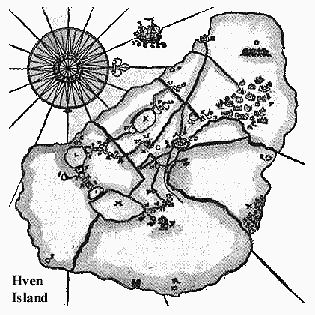 Together, Tycho and Kirstine would have eight children: Kirstine, Magdalene, Claus, Sophie, Elisabeth, Sidsel, Tyge and Jörgen. It was a union that seemed truely to have been for love, lasting almost thirty years and entered into against the advice of friends who felt it beneath a noble to be in such a relationship.
Together, Tycho and Kirstine would have eight children: Kirstine, Magdalene, Claus, Sophie, Elisabeth, Sidsel, Tyge and Jörgen. It was a union that seemed truely to have been for love, lasting almost thirty years and entered into against the advice of friends who felt it beneath a noble to be in such a relationship."He delivered lectures in Copenhagen by royal command in 1574; and in 1575 travelled through Germany to Venice. The execution of his design to settle at Basel was, however, anticipated by the munificence of Frederick II, king of Denmark, who bestowed upon him for life the island of Hveen in the Sound, together with a pension of 500 thalers, a canonry in the cathedral of Roskilde, and the income of an estate in Norway." [13]
Tycho's work was about to begin in earnest and its results would produce one of the most lasting legacies in the science of astronomy. It arrived in the form of meticulously recorded observations made from the island of Hven, revealed by the hand of another who's work would have an even larger influence upon 17th and 18th century science. All this would be accomplished using some of the most highly devloped instruments that European astronomy would see till the advent of the telescope in 1607. Shown at left is a drawing of the Island of Hven, courtesy Visualizing Tycho Brahe's Mars Data website. Before venturing to the Island of Hven and the meeting between Tycho Brahe and Johannes Kepler, let us now look to the life of our next great thinker—Galileo Bonaiuti de' Galilei. Next Page
Footnotes
1. Dreyer also questions Tycho's decision to enroll at this particular university, Tycho Brahe, pp. 24-26, but with good cause, reasons that the study of astrology, mathematics, alchemy and medicine were close enough to what Tycho required in pursuit of his goals to make going there worthwhile.
2. It is often mentioned that Tycho's nose was made of silver and gold and given his status and means, most appropriate, (see [2] below, Dreyer's Tycho Brahe, pp. 26-27). However, it is noted by some, such as Cecil Adams [5] and Fredric Ihren [6] that the false nose also had copper. Ihren wrote that when Tycho's tomb was opened in 24 June 1901 green marks were found on his skull, suggesting copper. Cecil Adams also mentions this green colouring which was noted by the medical experts who examined the remains. Since copper is much lighter than gold and a tad less than silver one can only image the weight of a nose made solely of gold or silver.
3. Digit in this sense; used in expressing the amount of overlap of the Sun and the Moon in an eclipse. The "digit", as used herein, is equal to half the length of the apparent diameter, given that the two objects being virtually the same apparent size from Earth; i.e. 10.5 digits would equal 5/6ths of the sun. Webster's Revised Unabridged Dictionary (1913): (n) One twelfth part of the diameter of the sun or moon; a term used to express the quantity of an eclipse; as, an eclipse of eight digits is one which hides two thirds of the diameter of the disk.
4. The full latin title of De stella nova is: De nova et nullius aevi memoria prius visa stella or "On the New and Never Previously Seen Star". Translation courtesy The Galileo Project website.
Chapter Four
Dangerous Concept, Dangerous Times: Galileo, Kepler and the Church
Present & Future Historical Bytes











© Legal Copyright Notice:
Unless otherwise stated, all images, screen shots, electronic materials including instructional, software, scripts and web pages referred to herein or incorporated by reference are copyrighted © by A Universe in Time. None of the content herein may be reproduced or copied in any manner from this website without the prior written permission of above indicated copyright holder(s). All images and orginal works of the author(s) used within the above or foregoing web pages are for the sole purpose of information and display at A Universe in Time website and have been used with the kind permission of the respective owner(s).
BACK TO THE TOP